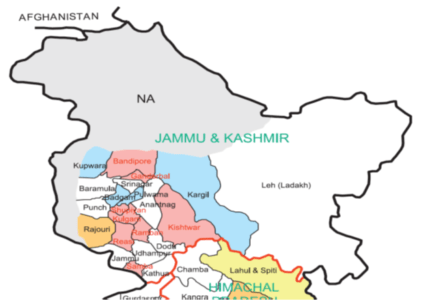Delimitation Commission
Context:
Delimitation Commission comprising of Chairperson Retd. Justice Ranjana Prakash Desai, Ex-Officio Member Shri Sushil Chandra (Election Commissioner) and Ex-Officio Member, Shri K.K Sharma (State Election Commissioner, J&K) today held a meeting in New Delhi with the Associate Members from Union Territory of Jammu and Kashmir, for seeking their suggestion/views on the process of delimitation in respect of Union Territory of Jammu and Kashmir.
What is Delimitation?
- Delimitation literally means the act or process of fixing limits or boundaries of territorial constituencies in a country or a province having a legislative body.
- The job of delimitation is assigned to a high power body. Such a body is known as Delimitation Commission or a Boundary Commission.
- In India, such Delimitation Commissions have been constituted 4 times – in 1952 under the Delimitation Commission Act, 1952, in 1963 under Delimitation Commission Act, 1962, in 1973 under Delimitation Act, 1972 and in 2002 under Delimitation Act, 2002.
- The Delimitation Commission in India is a high power body whose orders have the force of law and cannot be called in question before any court.
- These orders come into force on a date to be specified by the President of India in this behalf.
- The copies of its orders are laid before the House of the People and the State Legislative Assembly concerned, but no modifications are permissible therein by them.
Why Delimitation?
- To provide equal representation to equal segments of a population.
- Fair division of geographical areas so that one political party doesn’t have an advantage over others in an election.
- To follow the principle of “One Vote One Value”
How is delimitation done?
- After every census, the Parliament will enact a Delimitation Act, as per Article 82.
- As per Article 170, the states also get classified into territorial constituencies after every census, according to the said Act.
- Once the Act is enacted, the Central Government sets up a Delimitation Commission.
- The Commission then exercises the delimitation.
Delimitation Commission
The Delimitation Commission is a high-level body set up by an act of the Parliament.
- It is appointed by the country’s President.
- It works in tandem with the Election Commission of India.
- Delimitation Commission Members:
- A retired judge of the Supreme Court
- The Chief Election Commissioner
- State Election Commissioners (of the respective states)
Functions of Delimitation Commission
The Delimitation Commission is a high power body whose orders have the force of law. Its orders cannot be questioned in a court of law. The copies of the orders are laid before the Lok Sabha and the legislative assemblies concerned, but no change is permitted in them.
- The main task of the commission is redrawing the boundaries of the various assembly and Lok Sabha constituencies based on a recent census.
- The representation from each State is not changed during this exercise. However, the number of SC and ST seats in a state are changed in accordance with the census.
- The Delimitation Commission has to determine the number and boundaries of constituencies in such a manner that the population of all seats is the same, as far as possible practically.
- The Commission also identifies the seats to be reserved for the scheduled castes and scheduled tribes communities, in areas where their population is significant.
- If the members of the Commission have differing opinions, then the decision of the majority will be taken into consideration.
- The Commission releases draft proposals to the public through the Gazette of India and the official gazettes of states, and also in regional language newspapers.
- It also conducts public sittings wherein the public’s opinion is heard through written or oral representations.
- If found appropriate, changes are made to the draft proposal.
- The final order is published in the Gazettes and comes into effect by a date specified by the President.
| Year | Details | Based on |
| 1952 | First delimitation exercise post-independence. | 1951 census |
| 1963 | First delimitation exercise after the reorganisation of states in 1956. Only single-seat constituencies | 1961 census |
| 1973 | 1971 census | |
| 2002 | No changes in Lok Sabha seats or their apportionment between the various states | 2001 census |
| After 2031 census | Following the 84th amendment to the Constitution, in 2002, no delimitation of constituencies will be done till the first census after 2026.[2] | 2031 census |
Problems with Delimitation
- States that take little interest in population control could end up with a greater number of seats in Parliament. The southern states that promoted family planning faced the possibility of having their seats reduced.
- In 2008, Delimitation was done based on the 2001 census, but the total number of seats in the Assemblies and Parliament decided as per the 1971 Census was not changed.
- The constitution has also capped the number of Lok Shaba & Rajya Sabha seats to a maximum of 550 & 250 respectively and increasing populations are being represented by a single representative.
Steps to be taken
- A national consensus exercise should be started to sort out issues much before 2026.
- The weightage given by the Finance Commission to population can be reduced to 10%, or even 5%.
Way Forward
- Although the freeze on the number of seats in Lok Sabha and Assemblies should have been lifted after the 2001 Census, another amendment has postponed this until 2026.
- This was justified on the ground that a uniform population growth rate would be achieved throughout the country by 2026.
Source: PIB



Excellent Explanation